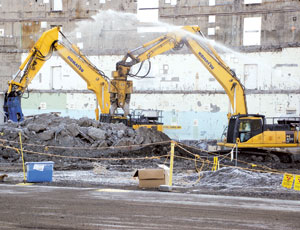The Dept. of Energy has announced how it will spend more than $9 billion in federal funds under the recently enacted economic-stimulus measure, with much of the money aimed at construction projects. DOE on March 31 released its plans for the American Recovery and Reinvestment Act's $6 billion to accelerate environmental cleanup work at former nuclear-weapons sites across 12 states around the country. Five days earlier, the agency disclosed its breakdown of $3.2 billion for a new Energy Efficiency and Conservation Block Grant program that the stimulus statute created.

The two largest recipients of the environmental cleanup funding will be the Hanford site in Washington state and the Savannah River site in South Carolina. The Richland Operations Office at Hanford will receive $1.635 billion, largely concentrated on projects to accelerate the cleanup of facilities, waste sites and groundwater along the Columbia River to support shrinking the active area of cleanup at the 586-sq-mile Hanford site to 75 sq miles or less by 2015. The Waste Treatment Plant, which has a stable annual funding level of $690 million, will not receive any stimulus funds, says Suzanne Heaston, spokeswoman for Bechtel’s vitrification plant.
Dave Brockman, manager of the DOE Richland Operations Office, says the stimulus funding should create or save approximately 4,000 jobs at the site.
Hanford’s Office of River Protection will receive $326 million to accelerate design and construction of infrastructure and systems for transfer of radioactive liquid waste from aging underground tanks, as well as design and construction of a high-level waste storage facility.
The Savannah River site will receive $1.615 billion, primarily for the decommissioning of nuclear facilities and contaminated areas throughout the site and reducing the site’s industrial area by 40% by September 2011.
The projects and the new funding are being managed by DOE’s Office of Environmental Management. Tiffany Edwards, a DOE spokeswoman, says funding decisions were based on contract and regulatory agreements already in place with “validated cost and schedule baselines.” DOE stipulates that funding, which will be released the week of March 30, should be spent by the end of 2011.
The $3.2 billion in new block grants can be used for a wide range of energy-efficiency activities. Construction-related applications include upgrades and energy audits for residential and commercial buildings, installing renewable-energy systems on state or local government buildings, developing and implementing building codes and inspections and setting up financial incentives for energy-conservation upgrades. Also eligible are projects to capture methane from landfills.
“The funding will be used for the cheapest, cleanest and most reliable energy technologies we have—energy efficiency and conservation—which can be deployed immediately,” DOE Secretary Steven Chu said. Of the $3.2-billion total, cities and counties will receive $1.9 billion and states and territories will get $770 million. Tribal governments’ share is $54 million. Funds are allocated by a formula that includes population and energy-consumption factors.
| Washington (Hanford area) | 1,961 |
|---|---|
| South Carolina (Savannah River site) | 1,615 |
| Tennessee (Oak Ridge) | 755 |
| Idaho (National Lab) | 468 |
| New Mexico (WIPP, Los Alamos) | 384 |
| New York (Brookhaven, West Valley) | 148 |
| Ohio (Miamisburg, Portsmouth) | 138 |
| Utah (Moab) | 108 |
| Illinois (Argonne National Lab) | 99 |
| Kentucky (Paducah) | 79 |
| California (Energy Tech. Engrg. Ctr., linear accelerator) | 62 |
| Multiple states (Uranium, thorium reimbursement) | 69 |
| Management and oversight | 70 |
| Source: DOE | |
California, the most populous state, will receive over $300 million of the block-grant aid, with $49.6 million of that going to the state energy office. California cities and counties will divide the rest. The city of Los Angeles will receive $37 million, San Diego $12.5 million, San Jose $8.8 million and San Francisco $7.7 million. The County of Los Angeles will receive $15.4 million.
The economic-stimulus measure directs DOE to distribute the other $456 million of the grant program under a competitive solicitation. Besides the new energy-efficiency block grants, DOE’s stimulus funding includes $5 billion in home weatherization aid and $3 billion for the State Energy Program. On March 12 DOE announced it was releasing an initial 10% of the funds from those two programs.



Post a comment to this article
Report Abusive Comment